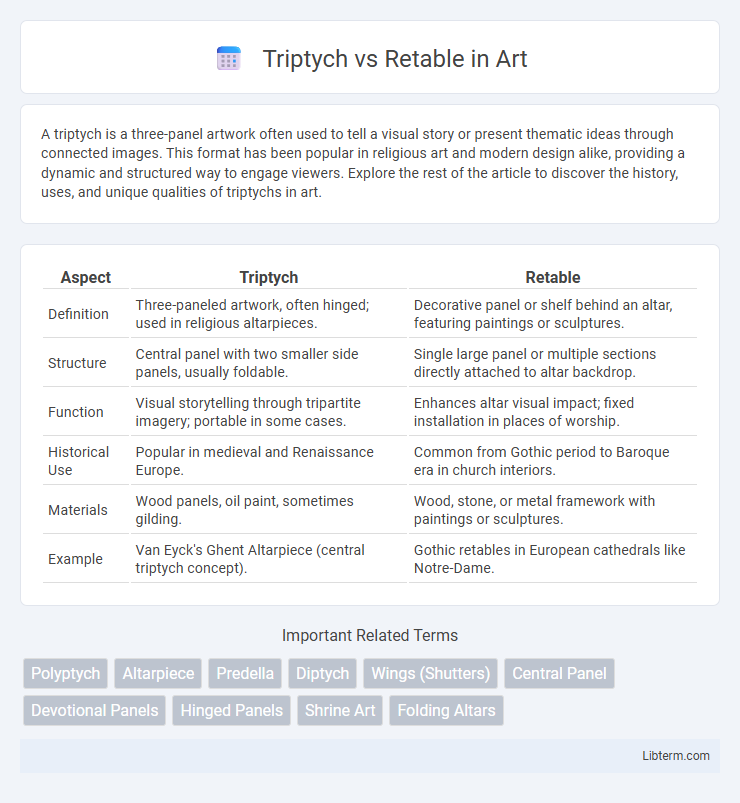A triptych is a three-panel artwork often used to tell a visual story or present thematic ideas through connected images. This format has been popular in religious art and modern design alike, providing a dynamic and structured way to engage viewers. Explore the rest of the article to discover the history, uses, and unique qualities of triptychs in art.
Table of Comparison
| Aspect | Triptych | Retable |
|---|---|---|
| Definition | Three-paneled artwork, often hinged; used in religious altarpieces. | Decorative panel or shelf behind an altar, featuring paintings or sculptures. |
| Structure | Central panel with two smaller side panels, usually foldable. | Single large panel or multiple sections directly attached to altar backdrop. |
| Function | Visual storytelling through tripartite imagery; portable in some cases. | Enhances altar visual impact; fixed installation in places of worship. |
| Historical Use | Popular in medieval and Renaissance Europe. | Common from Gothic period to Baroque era in church interiors. |
| Materials | Wood panels, oil paint, sometimes gilding. | Wood, stone, or metal framework with paintings or sculptures. |
| Example | Van Eyck's Ghent Altarpiece (central triptych concept). | Gothic retables in European cathedrals like Notre-Dame. |
Understanding Triptychs: Definition and Origins
Triptychs are three-paneled artworks hinged together, originating in early Christian art as portable altarpieces for worship. Each panel typically depicts related religious scenes, facilitating narrative storytelling and devotional focus within a compact format. This format evolved from Byzantine icons, influencing medieval and Renaissance art traditions across Europe.
What Is a Retable? Key Characteristics
A retable is an architectural structure or panel placed on or above an altar, often adorned with religious paintings, sculptures, or carvings, serving as a focal point in Christian liturgical settings. Key characteristics of retables include their fixed position behind the altar, intricate detailing, and often multiple compartments or panels arranged vertically or horizontally to depict biblical scenes or saints. Unlike triptychs, which are typically three-paneled and hinged for folding, retables are generally larger, non-movable, and integrated into the church's altar design.
Historical Evolution: Triptych and Retable Over Time
Triptychs originated in early Christian art during the Late Antiquity period, serving as portable altarpieces with three hinged panels that allowed private devotion and public display. Retables evolved primarily in medieval European churches from the 14th century onward, transforming into large, often elaborately carved or painted frameworks that filled the space behind the altar, reflecting the advancing Gothic and Renaissance artistic styles. Over time, triptychs remained favored for personal and small-scale worship, while retables became monumental fixtures enhancing liturgical settings and conveying complex theological narratives.
Structural Differences: Triptych vs Retable
A triptych consists of three hinged panels, typically with a central panel flanked by two smaller wings that can fold inward, allowing for portability and dynamic display options. In contrast, a retable is a single, often large, architectural structure placed behind an altar, featuring a fixed, multi-paneled composition integrated into the church's interior design. The triptych emphasizes movable, standalone art, whereas the retable serves as a permanent, ornate backdrop for religious ceremonies.
Artistic Purposes and Symbolism
Triptychs and retables both serve as multifaceted altarpieces in Christian art, with triptychs featuring three panels often depicting sequential or related biblical scenes, enhancing narrative depth and spiritual reflection. Retables, typically larger and more elaborate, function as a visual focal point in churches, combining sculptural and painted elements to symbolize divine presence and religious authority. Both forms harness symbolism through iconography and spatial arrangement, reinforcing theological themes and guiding worshippers' contemplation.
Common Themes and Iconography
Triptychs and retables commonly feature religious themes such as the Passion of Christ, the Virgin Mary, and saints. Both often utilize iconography like halos, the crucifix, and biblical narratives to convey spiritual messages and guide worshippers' devotion. The triptych's three-panel structure allows for sequential storytelling, while the retable typically serves as a single, elaborate backdrop for altar scenes.
Triptych vs Retable: Regional Variations
Triptychs are three-paneled artworks commonly associated with Northern European medieval churches, while retables often appear as large, elaborate altarpieces in Southern European, particularly Spanish and Italian, ecclesiastical settings. Triptychs emphasize portability and personal devotion, characterized by hinged panels that can close, whereas retables are typically fixed structures integrated into the architecture of the altar. Regional variations reflect cultural and liturgical differences, with Northern Europe favoring intimate, narrative-driven triptychs and Southern Europe focusing on monumental, richly decorated retables that serve as focal points in communal worship.
Materials and Techniques Used
Triptychs often utilize wood panels as their foundational material, with tempera or oil paints applied using fine brushes to create detailed, multi-paneled compositions. Retables typically feature carved wood or stone structures adorned with gilded elements, polychrome painting, and sometimes inlaid precious materials, emphasizing three-dimensional sculptural techniques. Both art forms require skilled craftsmanship, but triptychs highlight painted narrative scenes, while retables combine painting and relief sculpture for liturgical display.
Notable Examples of Triptychs and Retables
Notable examples of triptychs include Hieronymus Bosch's "The Garden of Earthly Delights," characterized by its three-paneled structure and intricate symbolism, and Rogier van der Weyden's "The Descent from the Cross," which emphasizes emotional intensity spread across three hinged panels. Famous retables include the Ghent Altarpiece by Jan van Eyck, an elaborate polyptych altarpiece featuring richly detailed religious imagery, and the Altarpiece of Veit Stoss in Krakow, noted for its intricate wood carvings and large-scale presentation behind the altar. These works highlight the triptych's panel-based narrative format and the retable's function as an integrated altar backdrop with focused devotional artwork.
Modern Influence and Contemporary Uses
Triptychs and retables have evolved from traditional religious art to prominent features in modern galleries and public installations, reflecting contemporary themes and abstract expressions. Artists utilize the triptych's three-panel format to explore narrative fragmentation and spatial dynamics, while retables often serve as modular backdrops in experimental art spaces, merging historical iconography with modern media. Contemporary uses emphasize interactivity and multimedia integration, redefining these forms beyond their liturgical origins into versatile platforms for artistic innovation.
Triptych Infographic

 libterm.com
libterm.com